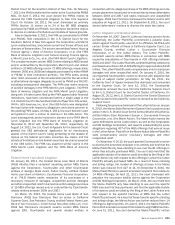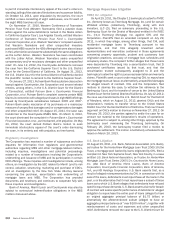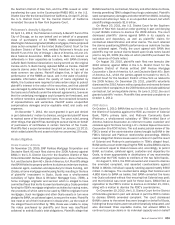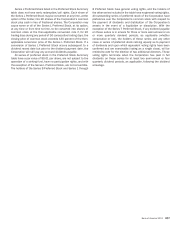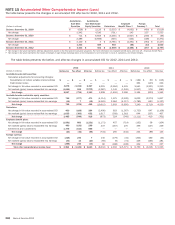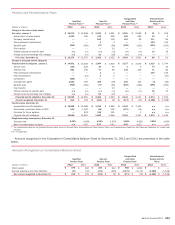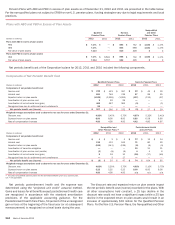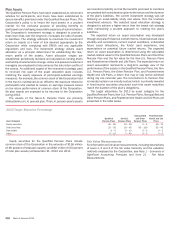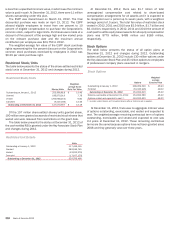Bank of America 2012 Annual Report Download - page 243
Download and view the complete annual report
Please find page 243 of the 2012 Bank of America annual report below. You can navigate through the pages in the report by either clicking on the pages listed below, or by using the keyword search tool below to find specific information within the annual report.Bank of America 2012 241
Rule. The Corporation measures and reports its capital ratios and
related information under Basel 2 on a confidential basis to U.S.
banking regulators during the required parallel period which will
continue until the Corporation receives regulatory approval to exit
parallel reporting and subsequently begin publicly reporting Basel
2 regulatory capital results and related disclosures.
In June 2012, U.S. banking regulators issued three notices of
proposed rulemaking (collectively, the Basel 3 NPRs), which, if
adopted as proposed, would materially change Tier 1 common,
Tier 1 and Total capital calculations, introduce new minimum
capital ratios and buffer requirements, expand and modify the
calculation of risk-weighted assets for credit and market risk (the
Advanced Approach) and introduce a Standardized Approach for
the calculation of risk-weighted assets, which would replace Basel
1 and provide a floor for minimum, adequately capitalized
regulatory capital requirements under the Prompt Corrective Action
framework. The Prompt Corrective Action framework establishes
categories of capitalization, including “well-capitalized,” based on
regulatory ratio requirements. U.S. banking regulators are required
to take certain mandatory actions depending on the category of
capitalization. No mandatory actions are required under the
Prompt Corrective Action framework for “well-capitalized” banking
entities.
Under the Basel 3 NPRs, Trust Securities will be phased out
of Tier 1 capital in equal annual installments over a three-year
transition period. Many of the changes to the composition of
regulatory capital are subject to a transition period where the
impact is recognized in 20 percent increments, phased in
incrementally each year over a five-year period. The majority of the
other aspects of the Advanced Approach were proposed to become
effective on January 1, 2013. The phase-in period for the new
minimum capital requirements and related buffers is proposed to
occur from the effective date of the Basel 3 NPRs through 2019.
U.S. banking regulators announced that they did not expect any
of the Basel 3 NPRs to become effective January 1, 2013. Final
rules for Basel 3 have not yet been issued by U.S. banking
regulators.
Under the Basel 3 NPRs the Corporation will be subject to the
Advanced Approach for measuring risk-weighted assets (Basel 3
Advanced Approach) when finalized and implemented. The Basel
3 Advanced Approach also requires approval by the U.S. regulatory
agencies of analytical models used as part of capital
measurement. If these models are not approved, it would likely
lead to an increase in the Corporation’s risk-weighted assets, which
in some cases could be significant. The Basel 3 Advanced
Approach, if adopted as proposed, is expected to substantially
increase the Corporation’s capital requirements.
In 2011, the Basel Committee on Banking Supervision issued
guidance on capital requirements for global, systemically
important financial institutions, including the methodology for
measuring systemic importance (the SIFI buffer), and the
arrangements by which the guidance will be phased in. As
proposed, the SIFI buffer would increase minimum capital
requirements for Tier 1 common capital from one percent to 2.5
percent, and in certain circumstances, 3.5 percent. U.S. banking
regulators have not yet issued proposed or final rules related to
the SIFI buffer.
On December 20, 2011, the Federal Reserve issued proposed
rules to implement enhanced supervisory and prudential
requirements and the early remediation requirements established
under the Dodd-Frank Wall Street Reform and Consumer Protection
Act. The enhanced standards include risk-based capital and
leverage requirements, liquidity standards, requirements for
overall risk management, single-counterparty credit limits, stress
test requirements and a debt-to-equity limit for certain companies
determined to pose a threat to financial stability. The final rules
are likely to influence regulatory capital and liquidity planning
processes, and may impose additional operational and compliance
costs on the Corporation.
Other Regulatory Requirements
The Federal Reserve requires the Corporation’s banking
subsidiaries to maintain reserve balances based on a percentage
of certain deposits. Average daily reserve balances required by
the Federal Reserve were $16.3 billion and $14.6 billion for 2012
and 2011. Currency and coin residing in branches and cash vaults
(vault cash) are used to partially satisfy the reserve requirement.
The average daily reserve balances, in excess of vault cash, held
with the Federal Reserve amounted to $7.9 billion and $6.5 billion
for 2012 and 2011. As of December 31, 2012, the Corporation
had cash in the amount of $8.5 billion and securities with a fair
value of $5.9 billion that were segregated in compliance with
securities regulations or deposited with clearing organizations.
The primary sources of funds for cash distributions by the
Corporation to its shareholders are capital distributions received
from its banking subsidiaries, BANA and FIA. In 2012, the
Corporation received $14.1 billion in dividends from BANA and FIA,
and returned capital of $6.6 billion to the Corporation. In 2013,
BANA can declare and pay dividends to the Corporation equal to
their retained net profits for 2013 up to the date of any dividend
declaration. The other subsidiary national banks paid $1.6 billion
in dividends to the Corporation in 2012 and can pay dividends in
aggregate of $203 million in 2013 plus an additional amount equal
to their retained net profits for 2013 up to the date of any such
dividend declaration. The amount of dividends that each subsidiary
bank may declare in a calendar year is the subsidiary bank’s net
profits for that year combined with its retained net profits for the
preceding two years. Retained net profits, as defined by the OCC,
consist of net income less dividends declared during the period.
NOTE 18 Employee Benefit Plans
Pension and Postretirement Plans
The Corporation sponsors noncontributory trusteed pension plans,
a number of noncontributory nonqualified pension plans, and
postretirement health and life plans that cover eligible employees.
As discussed below, certain of the pension plans were amended,
effective June 30, 2012, to freeze benefits earned. The plans
provide defined benefits based on an employee’s compensation
and years of service. The Bank of America Pension Plan (the
Pension Plan) provides participants with compensation credits,
generally based on years of service. For account balances based
on compensation credits prior to January 1, 2008, the Pension
Plan allows participants to select from various earnings measures,
which are based on the returns of certain funds or common stock
of the Corporation. The participant-selected earnings measures
determine the earnings rate on the individual participant account
balances in the Pension Plan. Participants may elect to modify
earnings measure allocations on a periodic basis subject to the
provisions of the Pension Plan. For account balances based on
compensation credits subsequent to December 31, 2007, the
account balance earnings rate is based on a benchmark rate. For
eligible employees in the Pension Plan on or after January 1, 2008,


